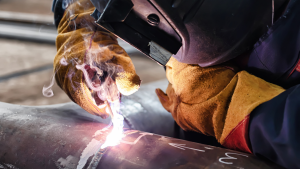Blog
In-Service Pipeline Welding: Ensuring Seamless Integrity and Operational Efficiency.
In-Service Pipeline Welding: Ensuring Seamless Integrity and Operational Efficiency.
In the world of industrial maintenance and repair, the ability to conduct welding operations while equipment and structures remain in service is an invaluable skill. The process of welding preformed in, also known as in-service welding. Allows for repairs and modifications to be carried out without the need for costly downtime or equipment shutdowns. This article explores the intricacies and importance of welding preformed in during in-service operations, highlighting its benefits, challenges, and best practices.
Understanding Welding Preformed In:
Welding preformed in refers to the welding process performed on a structure or equipment while it is actively in service or operational. This technique allows for repairs, modifications, or reinforcements to be made without the need to interrupt the production or operation process, resulting in substantial cost savings and minimized downtime.
Benefits of Welding Preformed In:
- Minimized Downtime: Welding preformed in eliminates the need for extended equipment shutdowns, thereby reducing production loss and associated costs. This is particularly beneficial in industries with continuous manufacturing processes or time-sensitive operations.
- Cost Savings: By avoiding equipment shutdowns, companies can save significant amounts of money. That would otherwise be spent on halted operations, lost production, and labor expenses associated with shutdowns and restarts.
- Increased Operational Efficiency: Welding preformed in allows for necessary repairs and modifications to be carried out promptly. Ensuring optimal performance and extending the service life of equipment and structures. This helps maintain operational efficiency without compromising safety.
- Enhanced Safety: In-service welding minimizes potential risks associated with dismantling and reassembling equipment. By avoiding large-scale disassembly, the likelihood of human error, accidents, and safety hazards is greatly reduced.
Challenges and Considerations:
- Safety Precautions: In-service welding requires strict adherence to safety protocols to minimize risks. Proper protective measures, including shielding gases, ventilation systems, and personal protective equipment, must be implemented to ensure the well-being of the welding personnel and surrounding environment.
- Access Limitations: Depending on the equipment or structure being welded, limited access points may pose challenges during the welding process. Skilled welders must work with confined spaces or challenging angles, requiring careful planning and the use of specialized tools or techniques.
- Material Compatibility: Welding preformed in demands expertise in dealing with various materials and their compatibility. Welders must possess a understanding of the base metal and filler materials to ensure a successful weld and maintain the structural integrity.
Best Practices for Welding Preformed In:
- Thorough Assessment: Conduct a comprehensive evaluation of the equipment or structure to determine the extent of repairs or modifications required. Otherwise this assessment should include identifying potential risks, evaluating material compatibility, and considering the long-term effects of the welding process.
- Welding Procedure Qualification: Develop and qualify welding procedures specific to in-service operations. These procedures should consider factors such as access limitations, material compatibility, and the ability to maintain the desired structural integrity and performance requirements.
- Skilled Workforce: Employ experienced and certified welders who possess the necessary skills and expertise in in-service welding. These professionals should be trained in working under challenging conditions. Following safety guidelines, and effectively adapting welding techniques to various scenarios.
- Continuous Monitoring: Implement a rigorous inspection and monitoring program to assess the quality and integrity of the welds during and after the welding process. This includes non-destructive testing techniques, such as ultrasonic or X-ray inspection, to ensure the welds meet the required standards.
Welding preformed in, or in-service welding, is a specialized and valuable technique while conducting repairs and modifications without the need for equipment shutdowns. By minimizing downtime, reducing costs, and ensuring operational efficiency. In-service welding plays a crucial role in maintaining the structural integrity and performance of equipment and structures. While challenges exist, adherence to safety precautions, thorough planning, and skilled workforce are vital for successful in-service welding operations. With the right approach, companies can achieve cost savings, enhance safety, and optimize productivity in their industrial operations.

Core Pipeline Services: www.corepipe.co.za
